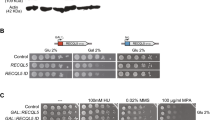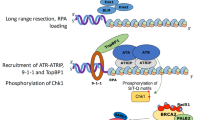Abstract.
In Saccharomyces cerevisiae, inactivation of the two DNA N-glycosylases Ntg1p and Ntg2p does not result in a spontaneous mutator phenotype, whereas simultaneous inactivation of Ntg1p, Ntg2p and Rad1p or Rad14p, both of which are involved in nucleotide excision repair (NER), does. The triple mutants rad1 ntg1 ntg2 and rad14 ntg1 ntg2 show 15- and 22-fold increases, respectively, in spontaneous forward mutation to canavanine resistance (CanR) relative to the wild-type strain (WT). In contrast, neither of these triple mutants shows an increase in the incidence of Lys+ revertants of the lys1-1 ochre allele. Furthermore, the rad1 ntg1 ntg2 mutant is hypersensitive to the lethal effect of H2O2 relative to WT, rad1 and ntg1 ntg2 mutant strains. Moreover, the rad1 ntg1 ntg2 strain is hypermutable (CanR and Lys+) upon exposure to H2O2, relative to WT, rad1 and ntg1 ntg2 strains. Mutagen sensitivity and enhanced mutagenesis in the rad1 ntg1 ntg2 triple mutant, relative to the other strains tested, were also observed upon exposure to oxidizing agents such as tert-butylhydroperoxide and menadione. In contrast, the sensitivity of the rad1 ntg1 ntg2 triple mutant to γ-irradiation does not differ from that of the WT. However, the triple mutant shows an increase in the frequency of Lys+ revertants recovered after γ-irradiation. The results reported in this study demonstrate that base excision repair (BER) mediated by Ntg1p and Ntg2p acts synergistically with NER to repair endogenous or induced lethal and mutagenic oxidative DNA damage in yeast. The substrate specificity of Ntg1p and Ntg2p, and the spectrum of lesions induced by the DNA-damaging agents used, strongly suggest that oxidized DNA bases, presumably oxidized pyrimidines, represent the major targets of this repair pathway.
Similar content being viewed by others
Author information
Authors and Affiliations
Additional information
Electronic Publication
Rights and permissions
About this article
Cite this article
Gellon, .L., Barbey, .R., Auffret van der Kemp, .P. et al. Synergism between base excision repair, mediated by the DNA glycosylases Ntg1 and Ntg2, and nucleotide excision repair in the removal of oxidatively damaged DNA bases in Saccharomyces cerevisiae. Mol Gen Genomics 265, 1087–1096 (2001). https://doi.org/10.1007/s004380100507
Received:
Accepted:
Issue Date:
DOI: https://doi.org/10.1007/s004380100507




